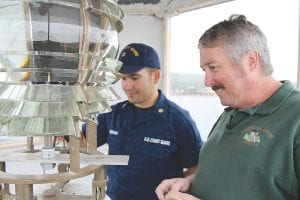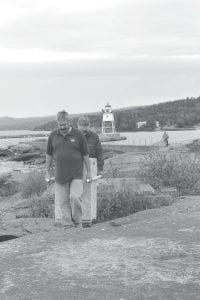Preparing for change. The Fresnel lens, circa 1885, in the Grand Marais lighthouse was removed on Wednesday, September 5 and replaced with a modern, solar-powered light. U.S. Coast Guard EM2 Zalvidar and lampist Kurt Fosburg inspect the lens in its pedestal in the lighthouse tower before disconnecting it.

A chapter closed in the storied history of the Grand Marais lighthouse on Wednesday, September 5, 2012. The era of the Fresnel lens came to a close as the U.S. Coast Guard upgraded the beacon to a modern, solar-powered light. Fortunately for lighthouse fans and history buffs, the antique lens did not go far. With the help of a lampist, the lens was moved to the Cook County Historical Society museum building on Broadway Avenue.
Kurt Fosburg of Marquette, Michigan, a boat caption in the summer— char tering tours to lighthouses—was the lampist who oversaw the removal and delivery of the Fresnel lens to the museum. Fosburg explained that lampist is an old world term for an individual who cares for the lighthouse lens. Lighthouse keepers cared for the area around a lighthouse but did not make repairs or adjustments to the lenses. That was a job for the lampist who came from the nearest Coast Guard depot. For the Grand Marais lighthouse, that was likely Detroit, said Fosburg, who acknowledged that his job is a “dying art” since most lighthouse lenses are now in museums.

Lampist Kurt Fosburg and Duane Ege, a board member of the Cook County Historical Society, carry the case holding the Fresnel lens from the lighthouse to its new home at the historical society museum. The museum building was formerly the lighthouse keeper’s house.
However, if the Coast Guard loans a lens to a museum, an approved lampist must oversee the removal and transport. Fosburg was ready for the task, with a specially constructed box with carrying handles and lots of bubble wrap to protect the lens, which he said is approximately 22 inches tall and 18 inches in diameter and weighs about 120 – 150 pounds. He said the lens is recorded as a 5th order light, the second from the smallest of lighthouse lenses.
However, Fosburg wasn’t sure just what he would find. According to The Story of Coast Guard Point by Harry F. Drabik, money for the first lighthouse in the Grand Marais harbor was appropriated in 1885 after the sinking of the Stranger near Grand Marais. The first tower was made of wood and it burned in the 1920s, which led to the construction of the current steel tower structure. It is not known if the original lens was installed in the replacement tower or not.
Fosburg said, “We will find clues to the age of the lens when we remove it.”
Carrie McHugh, director of the Cook County Historical Society museum was excited no matter the age—the lighthouse is an important part of the history of the Grand Marais harbor, she said.
As such, it would be carefully installed and maintained in accordance with U.S. Coast Guard requirements. McHugh stressed that the lens was “on loan” from the Coast Guard. The historical society was only able to accept the lens because of financial assistance from the Minnesota Coastal Zone program and the Lloyd K. Johnson Foundation. She said the museum must have a burglar alarm system and the lens display must have UV protection and other safeguards.
But before it could be put on display at the museum, the lens had to make the trip out of the lighthouse tower, along the breakwall and the rocky Coast Guard Point to the museum. Historical Society Board Member Duane Ege arrived to assist lampist Fosburg. The men, with the assistance of U.S. Coast Guard personnel DC2 Murphy, Seaman DeCaprio and EM2 Zalvidar carefully disconnected the historic lens, gingerly packed it in Fosburg’s container, and cautiously handed it down the ladder, through the hatch, to the base of the lighthouse.
There, Fosburg gave Museum Director McHugh some good news. “Someone kept it clean and polished for awhile,” he said. “It is in pretty good shape.”
He also said the lens bore a stamp with cursive handwriting—a clue to age of the lens. He said 1882 – 1885 were the only years that stamps with cursive writing were used. Fosburg said he had to study the lens a bit more and he would provide the historical society with a complete report, but he was delighted that the lens, with its brilliant prisms and polished brass settings, was in such good shape.
Fosburg and Ege then muscled the container across the narrow breakwall, up and down the concrete steps and over the worn, uneven rocks of the point. The nerve-wracking process was perhaps made a little more so by the presence of a film crew from WDSE-8 of Duluth. The public television station is filming a documentary on Lake Superior lighthouses and the story of the Grand Marais lighthouse lens will be part of that show to be broadcast sometime in December.
As the old lens was carried to its new home at the museum, Coast Guard personnel worked to install the new light, which EM2 Zalvidar described as a “four-tier VLB-44 (2.5) degree lantern with intensity set at 2280 candela.” The new light is “solarized,” using two 35-watt solar panels, one 20-watt solar panel and three 100 amp/hour Sunlyte batteries.
EM2 Zalvidar assured mariners and lighthouse enthusiasts that the characteristics of the light will remain the same. It will still flash on and off through the dark of night, illuminating a new chapter in the history of the Grand Marais lighthouse.
Changes to the fog signal
In addition to changing
the lens, the U.S. Coast
Guard removed the
VM-100 fog detector and
installed a remote control
unit (RCU) to operate the
FA-232 sound signal.
U.S. Coast Guard EM2
Zalvidar said from now on,
mariners adrift near the
harbor must energize the
fog signal by keying their
microphone five times on
marine channel 83A.


Loading Comments